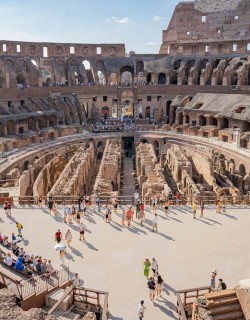The highly advanced, expansive and groundbreaking Roman waterway system, known as the aqueducts, was one of the greatest achievements in the ancient world. These mostly underground waterways carried disease away from the metropolitan city and provided indoor plumbing, running water and a sewage system. A testament to Roman engineering, some of the aqueducts are still in use today.
The aqueducts were built to last, constructed from stone, brick and a special volcanic cement called “pozzuolana”. The entire system included over 260 miles of waterways, but only 30 miles were above ground. During my first April in the city, my friend Matteo took me around the city. He was my neighbor in my first flat, and besides being a fantastic carbonara cook, exhilarating scooter driver, and amateur sommelier, he works as an English language tour guide. We started the day at the Vatican which was lovely but hectic. The crowds were a bit overwhelming, and I do recommend paying the extra money for the private Vatican tour with a company.
Anyways, after the Vatican we wandered across the Tiber river, past the Pantheon and towards the Colosseum. While all Roman architecture is stunning, the center of the city is crowded during daylight hours. A city truly connected with water, there are over 2,500 public water fountains in Rome. They are called “nasoni”, or big noses, and spout the same fresh, clean water that comes out of Roman taps. So even on a hot and sticky summer day of walking tours, you can stay hydrated without buying a new water bottle every hour. Even with proper hydration, I was getting a bit tired of the crowded streets in the center. Luckily, Matteo saved the best – and most peaceful – for last.
Parco Degli Aquedotti, or Park of the Aqueducts, is just 8 km from the city center but it feels like stepping into another city, and century. The rolling green fields are spotted with yellow and purple wildflowers, swaying in the late afternoon breeze. Towering majestically over the flowers are Aqua Claudia and Aqua Felix, two of the original eleven Roman aqueducts. These are the best preserved aqueducts in the city, and they are colossal. It is like stumbling into another millennium, the crowds and traffic of the city are replaced by bumblebees and fresh air. To the south and east you can see agricultural fields and grazing sheep.
The eleven Roman aqueducts were built over a period of 500 years, starting in 312 BC. With a population that reached one million at it’s height, water was crucial. The aqueducts were able to deliver one cubic meter of water per person, which is better than most modern cities. About 80% of Rome’s population was involved in agriculture, which made water the most important variable in the economy. Natural water sources, like springs, streams, rivers and lakes, were unevenly distributed across the country, and the aqueducts were crucial in production the food that fueled the empire. Also crucial was manpower; paid laborers, slaves and legions all played huge roles in the construction and maintenance of the system.
After a day of walking tours, constant simulation and gaping at the art that permeates her seductive streets, there is nothing better than a little quiet time in Roman nature. And there I was, gazing up at these mammoth arches over two thousand years after their construction. Elegant and proud, they remind Rome of her influence, innovation and everlasting beauty.
I moved out of the flat next to Matteo a month later, but we remain close friends. He has even taught me his secret carbonara recipe, although on that front I’m sworn to secrecy. I can tell you that seeing Rome with a Roman guide is the best way to go. Matteo showed me the intricacies of a city that I may have overlooked otherwise. Drink from the fountains, hop on a scooter if you can, and don’t miss the aqueducts.
~ Challis Popkey ~



